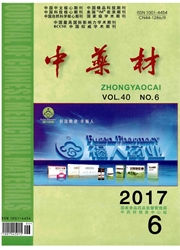

 中文摘要:
中文摘要:
目的:通过评价不同干燥方法、不同烘干温度对桑叶中黄酮类、生物碱类化合物含量的影响,揭示干燥过程中桑叶中黄酮类及生物碱类化合物的动态变化,为桑叶药材品质评价提供参考与技术支撑。方法:以不同干燥方法、程序升温烘干法、恒温烘干法对桑叶样品进行处理,采用HPLC-PDA联用技术分析桑叶中的黄酮类化合物;采用LC-TQ/MS技术分析评价桑叶中的生物碱类化合物。结果:不同烘干方法桑叶中黄酮类和生物碱类化合物的含量具有明显差异,黄酮类化合物由高到低的烘干方法依次为:冷冻干燥〉阴干〉烘干〉晒干〉微波干燥〉红外干燥;生物碱类化合物由高到低的烘干方法依次为:冷冻干燥〉阴干〉烘干〉晒干〉红外干燥〉微波干燥。随着烘干温度的升高,桑叶中黄酮类化合物的含量先升高后降低,以75~85℃烘干桑叶中黄酮类化合物含量为最高,55~65℃烘干为最低;DNJ含量以85~95℃烘干为最高,55~65℃烘干为最低;荞麦碱含量以95~105℃烘干为最高,45℃烘干为最低。不同含水量的桑叶中黄酮类和生物碱类化合物含量有差异,含水量30%~50%时,黄酮类化合物含量较低;含水量10%时黄酮类化合物含量为最高。两种生物碱类化合物含量随含水量不同表现出不同的变化趋势,DNJ和Fagomine的含量随样品含水量的减少逐渐升高,且55~65℃烘干样品明显高于95~105℃。结论:该研究结果为桑叶适宜的干燥方法和条件提供了参考和依据,为揭示干燥过程中桑叶中资源性化学成分的转化以及药材品质的形成奠定了一定基础。
 英文摘要:
英文摘要:
Objective: To find out dynamic changes of flavonoids and alkaloids in Morus alba leaves by analyzing influence of different drying method and drying degrees,in order to provide evidence for quality evaluation of Morus alba leaves.Methods: Different drying methods,programmed temperature methods and constant temperature methods were adopted to dry Morus alba leaves samples respectively.Contents of flavonoids and alkaloids were analyzed by HPLC-PDA and LC-TQ /MS respectively.Results: It's shown obviously that the content of flavonoids were influenced heavily by different drying methods.Methods that suitable for flavonoids were freezingdried shade-dried dried sun-dried microwave-dried infrared-dried; Methods that suitable for alkaloids were freezing-dried shade-dried dried sun-dried infrared-dried microwave-dried.The 55 ~ 65 ℃ group was shown to be the lowest in both flavonoids and DNJ while the 85 ~ 95 ℃ group was shown to be the best for DNJ.For fagomine,the 45 ℃ group was shown to be the lowest concentrations while the 95 ~ 105 ℃ group was shown to be the highest.Samples with different moisture were shown to be different in content of flavonoids and alkaloids.And samples with 10% moisture contain highest flavonoids while those with 30% ~ 50% moisture contain lowest flavonoids.Content of DNJ and fagomine raised as moisture decreasing.In addition,the 55 ~ 65 ℃ group was better than the95 ~ 105 ℃ one in alkaloids content.Conclusion: The results provide optimal drying methods and condition for drying Morus alba leaves,and foundations for uncovering biochemical transform of Morus alba leaves.
 同期刊论文项目
同期刊论文项目
 同项目期刊论文
同项目期刊论文
 期刊信息
期刊信息
